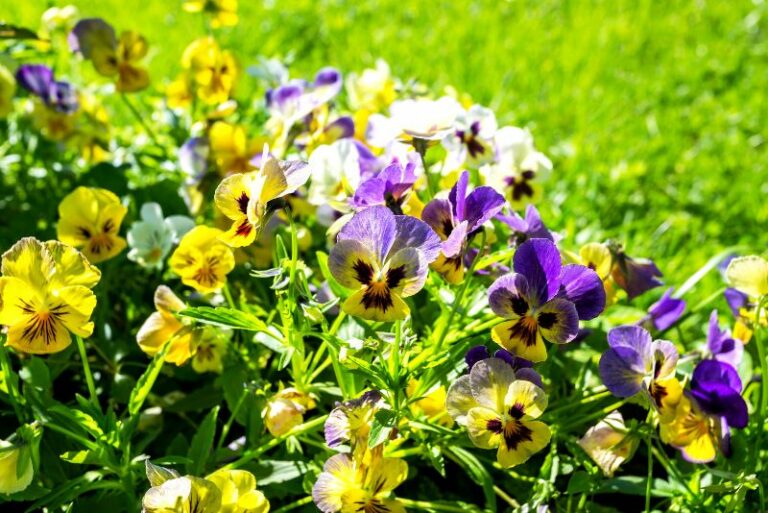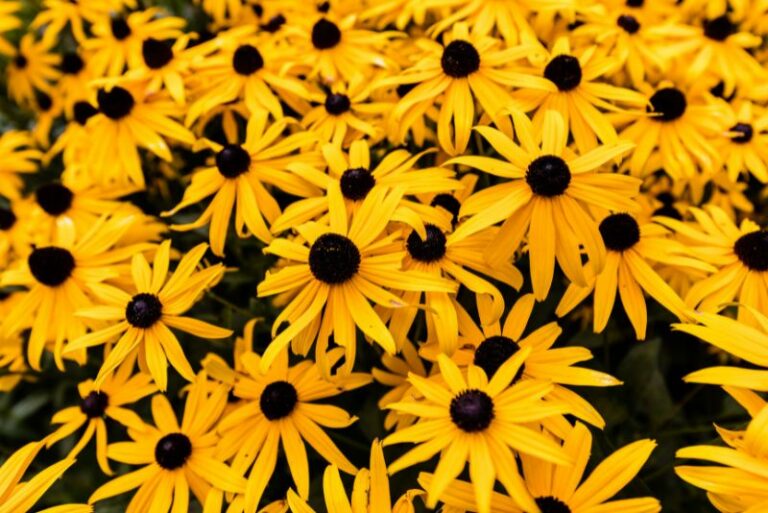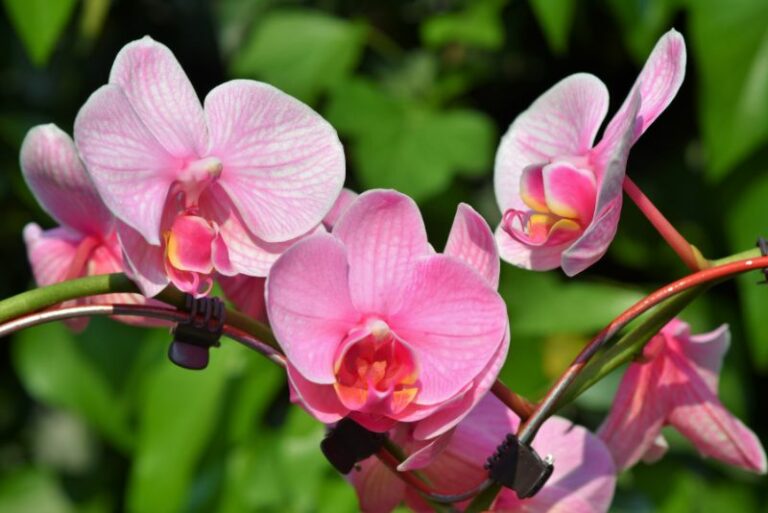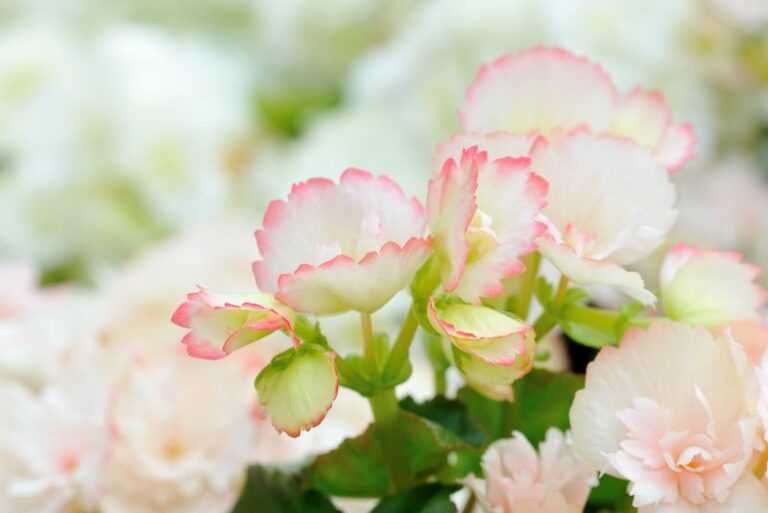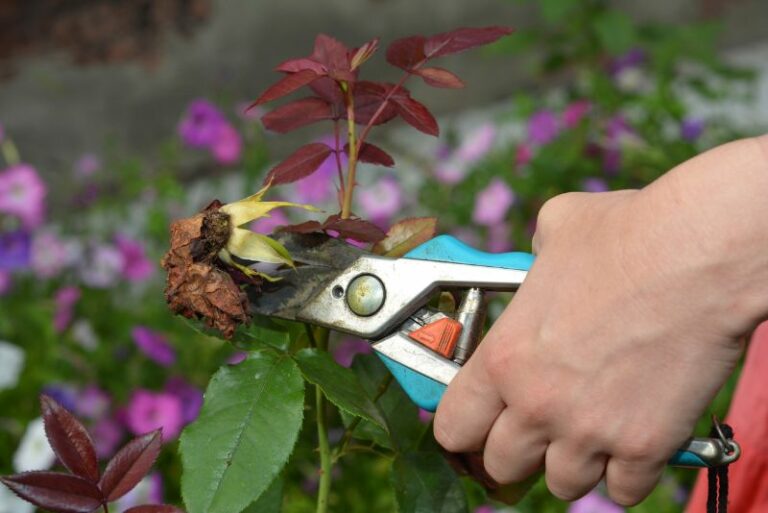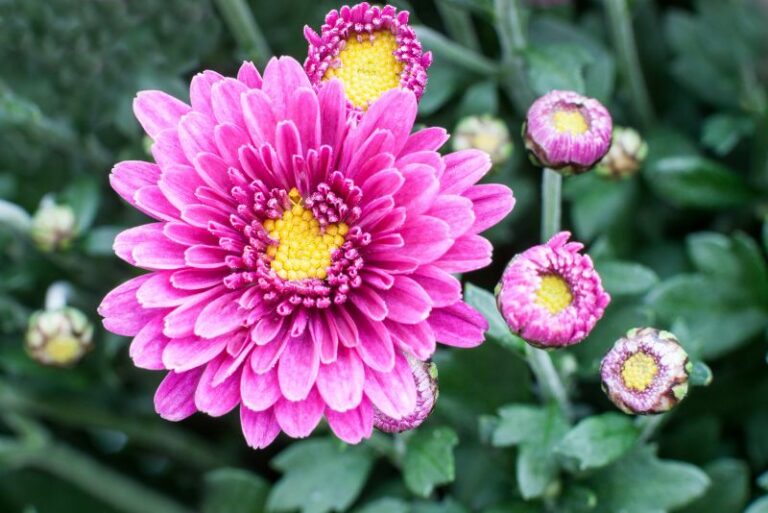How to Plant, Grow and Care For Petunias?
The vibrant troubadours of the garden, harmonizing in dazzling purples, passionate pinks, and a plethora of playful colors. As they bask under the sun’s tender caress, petunias are not just plants; they are a testament to the beauty of nature’s palette and the joy of horticulture. Their resilient blooms and pleasantly nonchalant care requirements make them a gardener’s delight, fitting for both the novice and the seasoned green thumb.
As you stand on the brink of diving into the rewarding world of growing petunias, you’re about to embark on a journey that will transform your garden into a canvas of color and life. And while their care might seem as breezy as a summer day, taking the right steps from planting to maintenance will ensure your petunias are the epitome of floral perfection.
Whether draping elegantly from containers, asserting their dominance in flower beds, or charming their way into hanging baskets, these flowers demand a spotlight. By the end of your journey, with spade in hand and heart open to learning, you’ll have discovered the artistry of cultivating these captivating blooms. Let’s unravel the mystery behind the art and finesse of planting, growing, and caring for petunias—the velvety sentinels of the garden.
Petunias Overview
Here is an overview table of Petunias:
| Plant type: Annual | Maturity date: 7-10 weeks after sowing | Attracts: Butterflies, Hummingbirds |
| Season: Spring to first frost | Maintenance: Moderate | Hardiness Zone: 9-11 |
| Pests: Aphids, slugs, snails, and caterpillars | Species: Different species including Petunia x hybrida, Petunia integrifolia etc. | Plant with: Other annuals like Marigolds, Zinnias |
| Slugs Family: Gastropoda | Growth rate: Fast | Planting depth: Same as the root ball of the plant |
| Exposure: Full sun | Soil type: Well-drained | Watering Requirement: Regular watering but do not overwater |
| Diseases: Fungal diseases like Botrytis, Powdery Mildew | Native area: South America | Don’t plant with: Plants that need less water |
| Genus: Petunia | Plant Spacing: 1 to 2 feet apart | Height: 6 inches to 4 feet depending on variety |
Please note that these are general guidelines and specific care instructions may vary based on the specific variety of Petunia you have. Always consult with a local horticulturist or extension service for the most accurate information.
All About Petunias
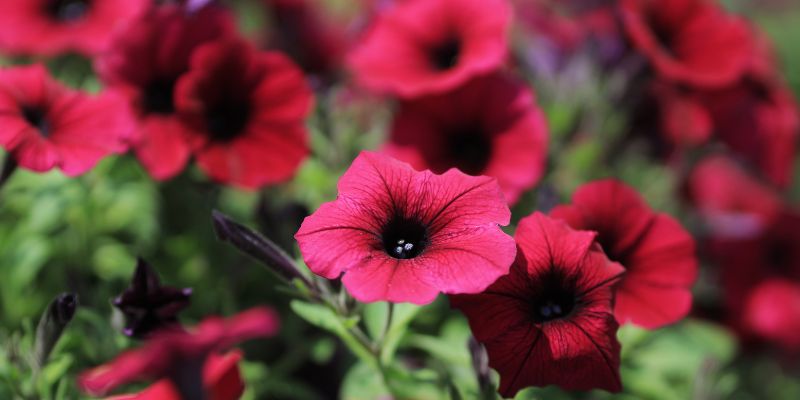
Petunias belong to the Solanaceae family, sharing lineage with tomatoes and tobacco, their adaptability to various growing conditions makes them a favorite among gardeners worldwide. They flourish in well-draining soil, ideally with neutral to slightly acidic pH levels, and have an affinity for full sun exposure, though they can tolerate partial shade. This sunlight devotion is crucial, for it drives their generous blooming, painting a vivid array of colors throughout the growing season.
With their proliferation comes a variety of species and hybrids, leading to a distinction between the four main types: grandiflora, multiflora, milliflora, and spreading (or wave). Grandiflora petunias are known for their large, showy flowers; multiflora petunias offer smaller, but more abundant blooms; milliflora petunias boast petite, prolific flowers; and spreading petunias create a carpet of color with their broad, horizontal growth.
Gardeners appreciate petunias not just for their beauty but also for their ease of care. Deadheading the spent blooms can encourage a fuller, more abundant display, and regular fertilization – every three to four weeks with a balanced, water-soluble blend – can promote vigorous growth and flowering. Additionally, these robust plants are capable of bouncing back after short periods of dryness, although a consistent watering routine will keep them looking their best. It’s this combination of visual appeal and resilient nature that renders petunias a distinguished presence in gardens and outdoor spaces.
Petunias Varieties
A Tapestry of Varieties: The Petunia Family
The diverse world of petunias ranges from heirlooms with a storied past to the modern hybrids engineered for brilliance and endurance. Breaking ground with the discovery of Petunia axillaris, the white moon petunia, and Petunia integrifolia, the violet-flowered wild petunia, gardeners have since cultivated an astonishing array of varieties.
Historical Blossoms: Heirloom Petunias
Heirloom varieties, cherished for their vintage charm, trace their origins to South America and bear the hallmarks of their wild ancestors. Their simple yet enchanting forms and fragrances hark back to their naturalized roots, invoking a bygone era of gardening simplicity.
Grandiflora Petunias
The grandiflora petunias command attention with their sizable, ruffled flowers boasting a diameter that can eclipse 5 inches. These garden divas unveil a visual feast of patterns including solid hues, veined markings, and star-like contrasts. They are renowned not just for their size, but for their sweet, subtle fragrance that becomes more pronounced as the evening air cools.
Multiflora Petunias
Multiflora petunias, while smaller in individual bloom size compared to grandifloras, compensate with a prolific quantity of flowers. They withstand rain better than their larger cousins, therefore presenting as a more weather-resilient option with a lighter scent that delicately perfumes the garden air.
Milliflora Petunias
The milliflora petunias, the miniature artists of the family, illustrate the saying “good things come in small packages.” Displaying blooms just an inch or two across, they deliver intense color saturation and often do not require deadheading. Their fragrance is faint, yet their visual impact in clusters creates an intoxicating mosaic of color.
Spreading Petunias
The spreading, or wave, petunias exemplify the power of ground cover. With their horizontal reach, they sweep across the garden, weaving a tapestry that cascades gracefully from containers and baskets. Hybrid advancements have produced variants such as the ‘Wave’, ‘Shock Wave’, ‘Easy Wave’, ‘Avalanche’, and ‘Tidal Wave’, each presenting unique growth patterns and dimensions for tailored garden design.
All petunia varieties share core characteristics: funnel-shaped flowers, a penchant for sunshine, and a gift for reblooming. Despite their differences, they dance harmoniously in the garden, unified by the genus’s trademark resilience and versatility—celebrating the unity and diversity of nature’s artwork.
Petunias Care Procedures
Optimal Light and Temperature for Thriving Petunias
Petunias have a distinct preference for light and temperature conditions, both of which are pivotal for fostering their full potential in your garden. Understanding these requisites is essential for any gardener wishing to cultivate these vibrant blooms.
Sunshine: The Fuel for Flowering
Petunias are sun-lovers and flourish when they receive a minimum of six hours of direct sunlight per day. This exposure is crucial because it encourages the plants to produce the maximum number of flowers and ensures the vibrancy of their colors. When petunias are placed in an area with insufficient sunlight, they may become leggy, with fewer blooms and diminished brightness.
To achieve the best results, position your petunias in a spot where they can bask in ample morning sunlight, which is generally less harsh than the afternoon sun. However, if you’re living in an area that experiences extremely hot summers, providing some afternoon shade will help protect the plants from excessive heat stress, which can lead to wilting or even plant death.
Temperature: A Delicate Balance
While petunias are tough plants, they thrive within certain temperature ranges. Mild to warm conditions typically yield the best growth, with optimal temperatures lying between 60°F to 80°F (16°C to 27°C). If you are growing petunias in a region with very hot summer temperatures, don’t fret – petunias can tolerate heat, but it’s essential to keep a consistent watering schedule to prevent them from drying out.
Petunias are sensitive to cold and should not be planted outside until the threat of frost has passed. They can handle cooler nights but consistently low temperatures or a sudden cold snap can be harmful. If an unexpected frost is forecasted and your petunias are already planted, consider covering them with frost blankets or bringing containers indoors to shield them from the cold.
Monitoring and Adjusting
Regularly monitor the plants to ensure they are receiving the proper light and are not being subjected to extreme temperature fluctuations. If potted petunias show signs of stress, don’t hesitate to relocate them to a more suitable environment. For petunias planted in the ground, providing temporary shade during heat waves or using frost protection methods can be effective strategies to maintain the ideal growing conditions.
By diligently managing the light and temperature, you give your petunias the environment they need to unfold their richest display of colors and to establish a hardy, long-lasting presence in your outdoor space.
Watering and Humidity: Cultivating Perfect Petunias
Water and humidity play a crucial role in the health and vitality of petunias. Striking the right balance is key to ensuring these flowers flourish.
Watering: Quenching Thirst Without Drowning
Petunias require consistent moisture but are equally averse to soggy conditions. Generally, a deep watering once a week should suffice, allowing the water to penetrate the soil to encourage deep root growth. During hot spells or in particularly dry climates, increasing the frequency to two or three times a week may be necessary.
To ascertain when it’s time to water, insert your finger into the soil up to the first knuckle. If the soil feels dry, it’s a green light to water. Use enough water to reach the roots at the base of the plant instead of just wetting the surface. Early morning is the best time to water, allowing the foliage to dry throughout the day and reducing the risk of fungal diseases.
Containers and hanging baskets may need daily watering, as they dry out faster than petunias in the ground. Always ensure that containers have drainage holes. Saturated soil can lead to root rot, which can quickly kill your petunias. Conversely, don’t allow the soil to dry out completely, as this can stress the plants, leading to flower and bud drop.
Humidity: Balancing Ambient Moisture
Petunias don’t demand high humidity but can cope with a range of atmospheric conditions. As long as they have adequate water at their roots and airflow around the foliage, they generally manage well.
Nevertheless, in regions with high humidity, be attentive to the spacing of your plants. Good air circulation is important to prevent moisture buildup on leaves and flowers that could lead to disease. If fungal problems do arise, treat early with fungicides, adhering strictly to the instructions provided for such products.
Mulching: Retaining Moisture and Fighting Weeds
Applying a layer of organic mulch like straw, shredded bark, or leaf mold can help maintain soil moisture levels and temperature. Mulch reduces the evaporation rate from the soil surface and discourages weed growth, which competes with petunias for water. A 2-3 inch layer of mulch is sufficient, but be careful not to bury the crown of the plant, as this can cause rot.
Observation and Adaptation: Key to a Lush Display
Carefully observe your petunias’ response to your watering regimen. Signs like wilting, yellowing leaves, or a halt in growth indicate a need to reassess your approach. By understanding and catering to your petunias’ thirst and adjusting for the humidity in your microclimate, you can achieve a vibrant and robust floral display that will be the envy of the neighborhood.
Soil Types, pH, and Preparation: Nurturing Prosperous Petunias
Understanding Soil Types
Soil is a crucial factor in the growth of petunias. These blooms are versatile and can thrive in a variety of soil types, each with its unique characteristics:
- Sandy Soil: Sandy soil drains well but doesn’t hold nutrients effectively. If your garden is sandy, enhance it with organic compost or well-rotted manure to improve fertility and water retention before planting petunias.
- Clay Soil: While nutrient-rich, clay soil tends to retain water, possibly leading to root rot. To make this soil suitable for petunias, incorporate organic matter to improve drainage and avoid waterlogging.
- Loamy Soil: Loamy soil is ideal for petunias. It has a balance of sand, silt, and clay, making it well-draining and fertile. Adding organic matter will still benefit the plants by providing additional nutrients and improving soil structure.
- Potting Mix: For containers and hanging baskets, use a high-quality potting mix. It’s often already optimized with a balance of materials like peat, pine bark, and perlite or vermiculite, which promote good drainage and aeration.
Soil pH for Petunias
Petunias prefer slightly acidic to neutral soil, with an ideal pH range of 5.5 to 7.0.
- Testing Soil pH: It’s important to test your soil’s pH before planting. You can purchase a soil test kit from a garden center or send a sample to an extension service. Based on the results, you can make the necessary adjustments to the soil.
- Adjusting Soil pH: If the soil is too alkaline (above 7.0), you can lower the pH by adding sulfur or aluminum sulfate. If it’s too acidic (below 5.5), incorporate lime to raise the pH. Make sure to follow the instructions on the packaging for proper application rates.
Preparing the Soil for Petunias
Good soil preparation can lead to a stunning display of petunias. Follow these steps:
- Clear the Planting Area: Remove weeds, debris, and other unwanted materials from your planting site.
- Loosen the Soil: Dig or till the soil to a depth of 8-10 inches to promote good root penetration.
- Add Organic Matter: Mix in a generous amount of compost or aged manure to enrich the soil. This step applies to all soil types and is essential for providing the necessary nutrients for your petunias.
- Ensure Good Drainage: If you’re dealing with heavy clay soil, consider creating raised beds or adding perlite or coarse sand to improve drainage.
- Pre-Planting Fertilization: Incorporate a balanced, slow-release fertilizer into the soil according to the manufacturer’s directions to give your petunias a healthy start.
- Water Preparations: Thoroughly water the area after planting. Ensure that the soil settles and removes air pockets. However, let the soil dry slightly before planting your petunias.
By diligently addressing your soil type, adjusting pH as needed, and adequately preparing your planting area, you’ll create the perfect foundation for petunias to thrive. An environment tailored to their needs allows these resilient and colorful flowers to burst forth in all their glory, providing a long season of enjoyment.
Petunias Care Procedures for Fertilizer
Petunias are not only vibrant and versatile, but they also respond remarkably well to correct fertilization, rewarding gardeners with lush foliage and continuous blooms. Here’s a detailed guide to optimizing petunia care through effective fertilization procedures:
Understanding Fertilizer Requirements
Petunias have a hearty appetite for nutrients, particularly during their peak flowering period. They benefit from regular feeding with a balanced, water-soluble fertilizer with an equal ratio of nitrogen, phosphorus, and potassium (e.g., 10-10-10 or 20-20-20). These essential nutrients support leaf growth, root development, and flower production, respectively.
Fertilizer Application Schedule
- Seedlings: Start feeding petunia seedlings with a diluted half-strength fertilizer solution once they have at least two sets of true leaves.
- Established Plants: For garden-planted petunias, begin a regular feeding schedule every 2 to 3 weeks, starting in late spring or when the first flowers are visible.
- Container Petunias: These may require more frequent feeding, as nutrients are more quickly depleted in pots. Fertilize container-grown petunias once weekly with a half-strength solution.
Procedures for Applying Fertilizer
- Dissolve or Mix: If using water-soluble fertilizer, ensure it is fully dissolved in water according to the package directions. Granular fertilizers should be evenly sprinkled on the soil surface near the base of the plants.
- Application Technique: Apply the fertilizer solution to the base of the plants, taking care to avoid wetting the foliage, as this can lead to leaf burn or disease proliferation.
- Aftercare: Following fertilizer application, water the plants thoroughly. This helps distribute the fertilizer into the soil and reduces the risk of root burn.
- Monitor Results: Observe how the petunias respond to the fertilization over the next few days. If you notice signs of nutrient burn, such as browned leaf tips, reduce the fertilizer concentration for subsequent feedings.
Adjusting Fertilization for Maximum Bloom
- Mid-Season Assessment: Petunias may signal the need for more phosphorus with fewer blooms mid-season. If this occurs, you can switch to a bloom booster formula (e.g., 10-30-20) to encourage more flowering.
- Slow-Release Options: For gardeners preferring less frequent application, slow-release granular fertilizers can be used at the beginning of the growing season and will gradually feed the plants for several months.
Organic Fertilization Alternatives
For those wanting to use organic fertilizers, options such as fish emulsion, seaweed extract, or compost tea are effective and sustainable choices. They not only provide necessary nutrients but also enrich the soil with organic matter.
Final Considerations in Fertilizing Petunias
Consistency and attention to your petunias’ growth and flowering cycles are key when fertilizing. Always follow the specific instructions provided on your fertilizer’s packaging, as over-fertilization can be just as detrimental to plant health as under-fertilization. By adhering to these care procedures for fertilizer application, your petunias will continue to showcase vivid blooms and robust vigor throughout their growing season.
Petunias Care Procedures for Repotting
Repotting petunias can give them a new lease on life by providing fresh soil and room to grow. Here is a step-by-step guide to ensure your petunias flourish after repotting:
Determining the Time for Repotting
- Root Check: Begin by checking the roots of your petunias. If you notice roots circling the bottom or growing through the drainage holes, it’s time to repot.
- Seasonal Timing: The best time to repot is in the spring, just before the growing season begins, as petunias are entering a period of rapid growth.
Steps for Repotting Petunias
- Select a New Pot: Choose a container that is one size larger than the current pot to ensure enough space for growth. Ensure it has adequate drainage holes.
- Prepare the New Potting Mix: Use a well-draining potting soil mix, similar to the one recommended for planting petunias in the ground. You can also add perlite or vermiculite to enhance drainage.
- Remove the Petunias: Gently remove the petunias from the old pot, trying to keep the root ball intact. Trim any dead or excessively long roots.
- Fill the New Pot: Add a layer of fresh potting mix at the bottom of the new pot, so when the petunias are placed in, the top of the root ball is about an inch below the rim.
- Position the Petunias: Center the petunias in the new pot and fill around the root ball with potting mix. Firm the soil gently to support the plants but avoid compacting it excessively.
- Water Thoroughly: After repotting, water the petunias well to settle the soil around the roots and eliminate air pockets.
Aftercare for Repotted Petunias
- First Few Weeks: Keep the soil moist but not waterlogged. Petunias may take some time to adjust to their new pot, so avoid fertilizing for the first few weeks.
- Sunlight: Place the repotted petunias in a location where they receive plenty of sunlight as they are sun-loving plants.
- Monitoring: Watch for signs of stress, such as wilting or yellowing leaves. These could indicate that the petunias are still settling in or that there’s an issue with watering.
Final Tips for Repotting Petunias
Repotting is a shock to any plant, so be patient with your petunias as they adjust. With proper care and maintenance, they will soon resume their normal growth pattern, ready to provide a lavish display of color. Remember that petunias are annuals, so repotting may not always be necessary unless you’re transferring them indoors for overwintering or to rejuvenate leggy plants mid-season.
Petunias Propagation Guide
Methods of Propagating Petunias
Petunias can be propagated through various methods, providing gardeners the joy of increasing their collection. Whether from cuttings, division, or seeds, each method has unique steps and requirements to ensure success.
Propagation from Cuttings
- Cutting Selection: Choose healthy, non-flowering stems for cuttings, ideally in the morning when the plant is most turgid.
- Preparation: Cut a 4-6 inch length of stem just below a leaf node using sharp, clean shears to minimize damage and reduce the risk of infection.
- Rooting Hormone: Although optional, applying rooting hormone to the cut end can enhance root development.
- Planting: Insert the cutting into a moist, well-draining potting mix, ensuring at least one set of leaves is above the soil surface.
- Environment: Place the cutting in a warm area with bright, indirect light, and maintain consistent moisture without overwatering.
- Root Development: In a few weeks, check for root growth by gently tugging on the cutting. Resistance indicates successful rooting.
- Transplanting: Once roots are established, you can transplant the petunia cutting to its final location, whether in the garden or a larger container.
Propagation from Division
While not as common as with some perennials, petunias can be divided if they are grown in a clump-forming manner.
- Plant Preparation: Water the petunias well a day before dividing to ensure they’re hydrated.
- Division: Gently lift the petunias from their container or garden space, and using clean, sharp tools, divide the root mass into sections, each with an adequate number of roots and shoots.
- Potting: Repot or replant the divisions immediately, following the same steps described in the repotting section above.
Propagation from Seeds
Petunias can also be grown from seeds, either collected from existing plants or purchased.
- Seed Starting Mix: Fill a tray or pots with a fine, well-draining seed starting mix.
- Sowing Seeds: Sprinkle petunia seeds on the surface of the mix, lightly pressing them into the soil but not covering them, as they require light to germinate.
- Moisture and Warmth: Keep the soil moist by covering with a plastic dome or using a mister and place the tray or pots in a warm location.
- Light: Once seeds are sown, provide plenty of bright, indirect light.
- Germination: Expect seedlings to emerge in 7-10 days. At this stage, remove the cover if used to increase airflow and reduce disease risk.
- Thinning: Once true leaves develop, thin out overcrowded seedlings to give each one enough space to grow.
- Transplanting: When seedlings have developed enough and outdoor conditions are favorable, you can transplant them to their permanent location.
Final Tips for Growing Petunias from Cuttings, Division, or Seeds
Whichever method of propagating petunias you choose, maintain consistent moisture and provide ample light and warmth to ensure success. Once propagated, follow the aftercare section above for healthy growth.
Troubleshooting
Troubleshooting Petunias
Growing petunias can sometimes be a challenge due to various environmental factors, pests, and diseases. Recognizing the issues early and taking the appropriate measures can ensure your petunias thrive and maintain their vibrant display throughout the growing season.
Growing Problems
- Leggy Growth: This occurs when petunias are not receiving enough light, causing them to stretch towards the light source. Ensure they are positioned to receive full sun for most of the day. Regular pinching of tips can also promote bushier growth.
- Poor or No Flowering: Commonly due to insufficient sunlight, over-fertilization, or lack of nutrients. Adjust light exposure, reduce fertilization, or perform a soil test to address nutrient deficiencies.
- Yellowing Leaves: Can be caused by overwatering, poor drainage, or nutrient deficiency. Ensure proper watering practices, well-draining soil, and balanced fertilization.
Pests
- Aphids: These small insects can cause petunia leaves to curl and become distorted. Use insecticidal soap or neem oil as a treatment.
- Spider Mites: Look for fine webs and stippled leaves. Increase humidity around the plants and apply miticide if necessary.
- Slugs and Snails: They feed on the tender foliage and petals. Use slug and snail baits or traps to control them.
Diseases
- Botrytis Blight (Gray Mold): This fungus causes gray, fuzzy mold on leaves, stems, and flowers, often in wet or humid conditions. Improve air circulation and avoid overhead watering. Remove affected parts and apply a fungicide when necessary.
- Root Rot: Often a result of overwatering, it leads to wilting and yellowing of the plant. Ensure proper drainage and avoid waterlogged conditions.
- Powdery Mildew: Appears as a white powdery coating on leaves, typically in dry, humid conditions. Improve air circulation, reduce overhead watering, and consider using a fungicide if the problem persists.
Close observation and prompt action are the best defenses against these issues, ensuring petunias continue to bring joy and color to gardens and landscapes.
Frequently Asked Questions
How often should I water my petunia plants?
Water petunias regularly to keep the soil consistently moist, but not waterlogged. During hot weather, they may need watering once a day, especially if they are in containers or hanging baskets.
Do petunias need to be deadheaded?
Yes, deadheading spent blooms can encourage more flowers and extend the blooming period. Simply pinch off the faded flowers to promote new growth.
What type of fertilizer is best for petunias?
Use a balanced, water-soluble fertilizer designed for flowering plants. Apply it every two to three weeks for optimal growth and bloom production.
Can petunias handle full sun?
Petunias thrive in full sun, requiring at least 6 hours of direct sunlight a day to produce abundant blooms.

